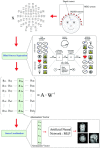Fast robust subject-independent magnetoencephalographic source localization using an artificial neural network
- PMID: 15593270
- PMCID: PMC6871672
- DOI: 10.1002/hbm.20068
Fast robust subject-independent magnetoencephalographic source localization using an artificial neural network
Abstract
We describe a system that localizes a single dipole to reasonable accuracy from noisy magnetoencephalographic (MEG) measurements in real time. At its core is a multilayer perceptron (MLP) trained to map sensor signals and head position to dipole location. Including head position overcomes the previous need to retrain the MLP for each subject and session. The training dataset was generated by mapping randomly chosen dipoles and head positions through an analytic model and adding noise from real MEG recordings. After training, a localization took 0.7 ms with an average error of 0.90 cm. A few iterations of a Levenberg-Marquardt routine using the MLP output as its initial guess took 15 ms and improved accuracy to 0.53 cm, which approaches the natural limit on accuracy imposed by noise. We applied these methods to localize single dipole sources from MEG components isolated by blind source separation and compared the estimated locations to those generated by standard manually assisted commercial software.
(c) 2004 Wiley-Liss, Inc.
Figures













References
-
- Abeyratne UR, Kinouchi Y, Oki H, Okada J, Shichijo F, Matsumoto K (1991): Artificial neural networks for source localization in the human brain. Brain Topogr 4: 3–21. - PubMed
-
- Ahonen AI, Hämäläinen MS, Knuutila JET, Kajola MJ, Laine PP, Lounasmaa OV, Parkkonen LT, Simola JT, Tesche CD (1993): 122‐channel SQUID instrument for investigating the magnetic signals from the human brain. Physica Scripta 49: 198–205.
-
- Baillet S, Riera JJ, Marin G, Mangin JF, Aubert J, Garnero L (2001): Evaluation of inverse methods and head models for EEG source localization using a human skull phantom. Phys Med Biol 46: 77–96. - PubMed
-
- Balish M, Sato S, Connaughton P, Kufta C (1991): Localization of im‐planted dipoles by magnetoencephalography. Neurology 41: 1072–1076. - PubMed
-
- Barth DS, Sutherling W, Broffman J, Beatty J (1986): Magnetic localization of a dipolar current source implanted in a sphere and a human cranium. Electroencephalogr Clin Neurophysiol 63: 260–273. - PubMed
Publication types
MeSH terms
Grants and funding
LinkOut - more resources
Full Text Sources

